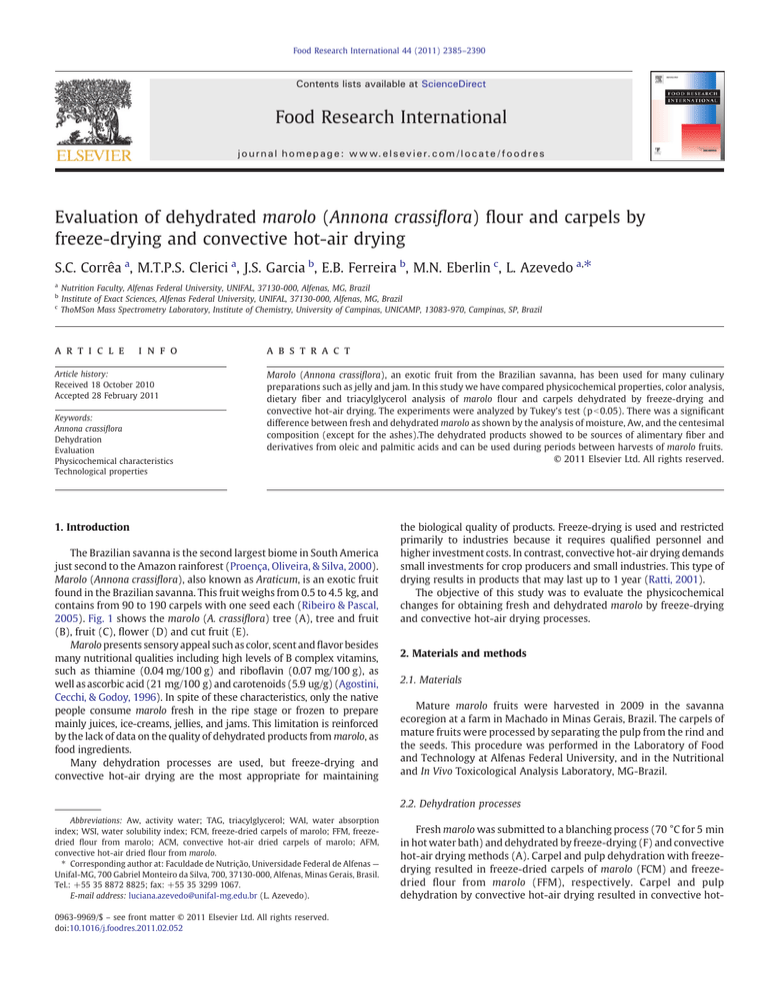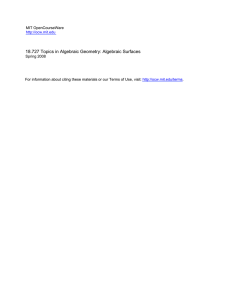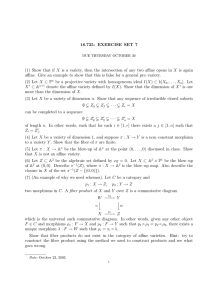
Food Research International 44 (2011) 2385–2390
Contents lists available at ScienceDirect
Food Research International
j o u r n a l h o m e p a g e : w w w. e l s ev i e r. c o m / l o c a t e / f o o d r e s
Evaluation of dehydrated marolo (Annona crassiflora) flour and carpels by
freeze-drying and convective hot-air drying
S.C. Corrêa a, M.T.P.S. Clerici a, J.S. Garcia b, E.B. Ferreira b, M.N. Eberlin c, L. Azevedo a,⁎
a
b
c
Nutrition Faculty, Alfenas Federal University, UNIFAL, 37130-000, Alfenas, MG, Brazil
Institute of Exact Sciences, Alfenas Federal University, UNIFAL, 37130-000, Alfenas, MG, Brazil
ThoMSon Mass Spectrometry Laboratory, Institute of Chemistry, University of Campinas, UNICAMP, 13083-970, Campinas, SP, Brazil
a r t i c l e
i n f o
Article history:
Received 18 October 2010
Accepted 28 February 2011
Keywords:
Annona crassiflora
Dehydration
Evaluation
Physicochemical characteristics
Technological properties
a b s t r a c t
Marolo (Annona crassiflora), an exotic fruit from the Brazilian savanna, has been used for many culinary
preparations such as jelly and jam. In this study we have compared physicochemical properties, color analysis,
dietary fiber and triacylglycerol analysis of marolo flour and carpels dehydrated by freeze-drying and
convective hot-air drying. The experiments were analyzed by Tukey's test (p b 0.05). There was a significant
difference between fresh and dehydrated marolo as shown by the analysis of moisture, Aw, and the centesimal
composition (except for the ashes).The dehydrated products showed to be sources of alimentary fiber and
derivatives from oleic and palmitic acids and can be used during periods between harvests of marolo fruits.
© 2011 Elsevier Ltd. All rights reserved.
1. Introduction
The Brazilian savanna is the second largest biome in South America
just second to the Amazon rainforest (Proença, Oliveira, & Silva, 2000).
Marolo (Annona crassiflora), also known as Araticum, is an exotic fruit
found in the Brazilian savanna. This fruit weighs from 0.5 to 4.5 kg, and
contains from 90 to 190 carpels with one seed each (Ribeiro & Pascal,
2005). Fig. 1 shows the marolo (A. crassiflora) tree (A), tree and fruit
(B), fruit (C), flower (D) and cut fruit (E).
Marolo presents sensory appeal such as color, scent and flavor besides
many nutritional qualities including high levels of B complex vitamins,
such as thiamine (0.04 mg/100 g) and riboflavin (0.07 mg/100 g), as
well as ascorbic acid (21 mg/100 g) and carotenoids (5.9 ug/g) (Agostini,
Cecchi, & Godoy, 1996). In spite of these characteristics, only the native
people consume marolo fresh in the ripe stage or frozen to prepare
mainly juices, ice-creams, jellies, and jams. This limitation is reinforced
by the lack of data on the quality of dehydrated products from marolo, as
food ingredients.
Many dehydration processes are used, but freeze-drying and
convective hot-air drying are the most appropriate for maintaining
the biological quality of products. Freeze-drying is used and restricted
primarily to industries because it requires qualified personnel and
higher investment costs. In contrast, convective hot-air drying demands
small investments for crop producers and small industries. This type of
drying results in products that may last up to 1 year (Ratti, 2001).
The objective of this study was to evaluate the physicochemical
changes for obtaining fresh and dehydrated marolo by freeze-drying
and convective hot-air drying processes.
2. Materials and methods
2.1. Materials
Mature marolo fruits were harvested in 2009 in the savanna
ecoregion at a farm in Machado in Minas Gerais, Brazil. The carpels of
mature fruits were processed by separating the pulp from the rind and
the seeds. This procedure was performed in the Laboratory of Food
and Technology at Alfenas Federal University, and in the Nutritional
and In Vivo Toxicological Analysis Laboratory, MG-Brazil.
2.2. Dehydration processes
Abbreviations: Aw, activity water; TAG, triacylglycerol; WAI, water absorption
index; WSI, water solubility index; FCM, freeze-dried carpels of marolo; FFM, freezedried flour from marolo; ACM, convective hot-air dried carpels of marolo; AFM,
convective hot-air dried flour from marolo.
⁎ Corresponding author at: Faculdade de Nutrição, Universidade Federal de Alfenas —
Unifal-MG, 700 Gabriel Monteiro da Silva, 700, 37130-000, Alfenas, Minas Gerais, Brasil.
Tel.: +55 35 8872 8825; fax: +55 35 3299 1067.
E-mail address: luciana.azevedo@unifal-mg.edu.br (L. Azevedo).
0963-9969/$ – see front matter © 2011 Elsevier Ltd. All rights reserved.
doi:10.1016/j.foodres.2011.02.052
Fresh marolo was submitted to a blanching process (70 °C for 5 min
in hot water bath) and dehydrated by freeze-drying (F) and convective
hot-air drying methods (A). Carpel and pulp dehydration with freezedrying resulted in freeze-dried carpels of marolo (FCM) and freezedried flour from marolo (FFM), respectively. Carpel and pulp
dehydration by convective hot-air drying resulted in convective hot-
2386
S.C. Corrêa et al. / Food Research International 44 (2011) 2385–2390
Fig. 1. A marolo (Annona crassiflora) tree (a), tree and fruit (b), fruit (c), flower (d) and cut fruit (e).
air dried carpels of marolo (ACM) and convective hot-air dried flour
from marolo (AFM). After dehydration, marolo was ground in a blender
and sifted for the uniformization of the flour granules.
For the freeze-drying (F) method, a LIOTOP-L101 drier (Brazil, São
Carlos, Liobras) was used. The temperature and pressure in the closed
drying chamber were −51 °C and 250 Pa, respectively. Convective
hot-air drying (A) was conducted with a 400 ND drier with air circulation (Brazil, Vargem Grande Paulista, Nova Ética). The air temperature was held at 50 °C for 20 h, followed by 70 °C for 11 h until the
moisture dropped below 10 g/100 g.
Minolta (1994). The chrome value was calculated as shown in Eq. (1),
and the saturation angle as shown in Eq. (2).
h
i
2
2 1=2
ChromeðCÞ = ðaÞ + ðbÞ
Hue angle ðhÞ = tan
−1
ðb = aÞ
ð1Þ
ð2Þ
2.4. Analysis of triacylglycerol (TAG) by mass spectrometry — MALDI
Q-TOF MS
2.3. Physicochemical characterization of the fresh pulp and dehydrated
products
The moisture content was determined with AOAC method No.
934.06 (1997). The water activity (Aw) was measured at 25 °C using
an electric hygrometer Aqualab Lite (Decagon®).The ash content of
the pulp was estimated by incineration in a muffle furnace at 550 °C
(AOAC No. 923.03, 1997). The protein content was determined with
the Kjeldahl method with a conversion factor of 6.25 (AOAC No.
960.52, 1997). The lipid content was analyzed gravimetrically
following the procedures in Bligh and Dyer (1959). Available
carbohydrate was estimated by the difference between the whole
mass and the sum of protein, fat, ash and moisture. The pH was
measured using an EXTECH Instruments microcomputer pH-vision
GEHACA®, model PG1800. The level of titratable acidity is expressed as
malic acid (AOAC, 1997). Dietary fiber was measured using AOAC
Method 985.29 (AOAC, 1997), which was performed with a Total
Dietary Fiber Assay Kit purchased from Sigma-Aldrich, USA. The
specific volume (mL/g) and the specific density (g/mL) were
determined by the displacement of hexane in a 100 mL graduated
cylinder. The water absorption index (WAI) and water solubility index
(WSI) were determined with procedures used by Anderson, Conway,
Pfeifer, and Griffin (1969). Color was determined by means of a
colorimeter Color Reader CR-10 (Konica Minolta®), by reflectance,
determining the components L* to represent luminosity (0 = black;
100 = white), a (+a = redness; − a = greenness), and b (+b =
yellowness; −b = blueness), according to the CIE-L*a*b* system. The
chrome (C*) and hue angle (h*) values were calculated as described by
Analysis of triacylglycerol was performed once the dehydration
process may lead to lipidic alterations through oxidative damage,
modification of the fatty acid profile as well as the characteristics of
the lipidic fraction compared to the non-processed product (Nawar,
1993).
Marolo pulp oil was extracted using only n-hexane. For that purpose,
100 mg of the pulp was weighed in a tube, and 1 ml of n-hexane was
added. The mixture was then homogenized by vortexing for 2 min.
Afterwards, the tubes were centrifuged for 1 min, and the samples were
analyzed by MALDI Q-TOF MS. For this task, 2 μL of the n-hexane phase
was placed on the MALDI plate for the identification of triacylglycerols
and kept at room temperature until the solvent was completely
evaporated. MALDI matrix (1 μL) was added to the sample, and the
sample was dried at room temperature. The matrix was prepared from
1% (m v− 1) 2,5-dihydroxybenzoic acid dissolved in 1000 μL methanol.
MALDI Q-TOF mass spectra were acquired in a MALDI Q-TOF
Premier mass spectrometer (Waters — Micromass, Manchester, UK).
The mass spectra were obtained in the positive ion mode (LDI+) with
a fixed nitrogen ion source using the following parameters: mass range
from 700.0 to 1000.0 Da, mass threshold of 200.0 Da, a scan time of 2 s,
a resolution of 10,000 in “V” mode, a trigger threshold of 700 mV, a
signal sensitivity of 80 mV and a microchannel-plate photomultiplier
set to 2100 V. Each spectrum was collected over a 1-s scan, and the
spectra were accumulated for 1 min. The instrument was controlled by
the MassLynx 4.1v software (Waters — Micromass, Manchester, UK).
All data obtained from MALDI Q-TOF MS were analyzed using the same
software.
S.C. Corrêa et al. / Food Research International 44 (2011) 2385–2390
2.5. Statistical analysis
All reported values represent the average value for the analysis of
at least three separate replicates. ANOVA was performed, followed by
a Tukey's test (p b 0.05).
3. Results and discussion
3.1. Physicochemical characterization
Table 1 shows the results of physicochemical characteristics of
fresh and dehydrated marolo.
In relation to moisture, fresh marolo had 77.21 g/100 g m ± 0.42
moisture, and the dehydrated marolo products, FCM, FFM, ACM and
AFM, had 3.9 g/100 g ± 0.17, 3.6 g/100 g ± 0.20, 7.1 g/100 g ± 0.10
and 4.2 g/100 g ± 0.87 moisture, respectively.
There were no significant differences in moisture from the flours
made with both drying processes; however, ACM had a higher moisture
degree than the rest of the dehydrated products. Almost all deterioration processes that occur in food are influenced by the mobility and
concentration of water (Le Page, Mirade, & Daudin, 2010), so it is
necessary to control the moisture and the Aw of food to their increase
shelf life. In this study, the dehydrated products had moisture levels
lower than 10 g/100 g and Aw values lower than 0.60 (Table 1), which
according to Troller (1980), prevents microorganisms, xerophilic molds
and osmophilic yeasts from growing because they typically grow
between 0.60 and 0.65 Aw.
As for the amount of minerals found in the marolo products, the
ashes content (Table 1) revealed no significant differences in the
amount of minerals found in the samples. However, dehydrated
marolo products presented significant lower protein levels when
compared to fresh marolo, but there was no significant difference
among the dehydrated products. This loss might be due to the ammonia volatilization occurred during the blanching of the samples, which
is performed at height temperatures (Ambasankar & Balakrishnan,
2010; Byrnes, 2000). It is worth highlighting the higher amount of
lipids presented by FFM and FCM. The great porosity presented by the
freeze-dried products contributed for the penetration of the solvent
with intensity between the canaliculi formed after the dehydration,
contributing for a better extraction of lipids content. In this case there
was no interference from water, which could be competing with the
solvent, bonding itself to the nutrients through hydrogen bonds. Such
differences determined the carbohydrate content, which is obtained
by the remainder between the whole mass and the sum of protein, fat,
ash and moisture.
The acidity results obtained for fresh and dehydrated marolo
products showed significant variation between the fresh fruit and the
FCM form (Table 1). However, the pH increased slightly from baseline
for all of the dehydrated samples. Similar results for pH were found by
Miranda, Maureira, Rodriguez, and Vega-Gálvez (2009) in a study on
dehydrated Aloe vera. The decrease in acidity in FCM and the increase
2387
in pH in all the dehydrated samples may be due to the loss of volatile
acid compounds during the thermic process before dehydration (Silva,
Finger, & Corrêa, 2008).
In relation to the fiber analysis, there was a decrease in insoluble
dietary fiber in both types of dehydrated fruit carpels (Table 2)
compared to the fresh carpels and FFM. Among the dehydrated
products, the FFM had a higher insoluble fiber content. For the soluble
dietary fiber, there was no significant difference between the samples.
The values of total dietary fiber (TDF), even those that were not
analyzed statistically, decreased in all of the dehydrated samples
compared to the fresh marolo carpels. As such, the grinding and the
drying processes influence the fiber content of marolo products. In a
previous study, Gutkoski and Pedó (2000) observed a decrease in the
amount of oat fibers when they submitted oats to high temperatures.
These results are not consistent with those from Nilnakara,
Chiewchan, and Devahastin (2009), who reported that drying at
temperatures of 70, 80 or 90 °C had no significant effect on the
composition of dietary fiber powder in the outer leaves of cabbage.
However, it is important to consider that freeze-dried and convective hot-air dried marolo had a high fiber content (15.88 to 25.78 g/
100 g) compared to other dehydrated fruits, e.g., 22.1 g/100 g in green
apple, 19.3 g/100 g in melon skin and 26.3 g/100 g in peach (Chang,
Lee, Lin, & Chen, 1998).
The high fiber content associated to the flavor and exotic aroma
makes the dehydrated marolo products potentially usable in many
food preparations, aiming to increase the fiber content of fast preparing and/or instantaneous flours, or powder compounds for juices.
Fresh marolo presented a higher specific volume and a lower
specific density compared to the ACM, AFM and FFM samples (Table 3).
The FCM had, however, a higher specific volume and a lower specific
density than the rest of the products, either fresh or dehydrated. This
discrepancy may be due to little or no shrinkage in the freeze-dried
products (Krokida & Philippopoulos, 2006), which could have caused
them to have a large volume and lower specific density. This does not
occur with the FFM because there was reduction in the size of granules
during the process of grinding.
The results for WAI revealed a decrease in the water absorption
from dehydrated products compared to fresh marolo (Table 3).
Because the analysis was performed over a 30 min period, this lapse of
time was probably insufficient to hydrate the fiber in the dehydrated
products, and as a result, the hydrated soluble fiber from marolo fresh
had a better absorption index. The WSI index showed a decrease in
the solubility of the convective hot-air dried samples compared to the
fresh samples. For the AFM, this index also had a lower value than the
freeze-dried products. This low value may result from the interaction
between nutrients, which may have occurred once these samples
were submitted to high temperatures.
As for the color analysis performed on the samples as observed in
Fig. 2 and Table 3, there was some browning in the convective hot-air
dried samples, whereas the freeze-dried samples had a lighter coloring
compared to the fresh fruit.
Table 1
Physical and chemical properties of fresh marolo, freeze-dried carpels of marolo (FCM), freeze-dried flour from marolo (FFM), convective hot-air dried carpels of marolo (ACM) and
convective hot-air dried flour from marolo (AFM)a.
Parameters
Fresh
FCM
FFM
ACM
AFM
Awb
Ashc, g/100 g
Proteinc(N × 6,25), g/100 g
Total lipids c, g/100 g
Carbohydratesc, g/100 g
Acidity (g/100 g malic acid)
pH
0.980 ± 0.01a
3.38 ± 0.22a
12.51 ± 0.60a
8.44 ± 0.64b
75.68 ± 2.61b
1.23 ± 0.02a
4.97 ± 0.04c
0.185 ± 0.00b
3.55 ± 0.01a
8.12 ± 0.16b
10.43 ± 0.25a
77.89 ± 0.18ba
0.74 ± 0.02b
5.34 ± 0.03ba
0.163 ± 0.01c
3.43 ± 0.11a
8.18 ± 0.29b
10.23 ± 0.07a
78.15 ± 0.24ba
1.07 ± 0.28ba
5.34 ± 0.01ba
0.167 ± 0.01c
3.55 ± 0.05a
8.46 ± 0.56b
9.13 ± 0.33b
78.86 ± 0.16ba
0.95 ± 0.02ba
5.31 ± 0.04b
0.176 ± 0.00bc
3.44 ± 0.02a
7.68 ± 0.13b
8.84 ± 0.18b
80.04 ± 0.66a
1.07 ± 0. 27ba
5.42 ± 0.06a
a
Values are the mean ± standard errors of five independent determinations. Means followed by different letters in the horizontal were significantly from each other in the Tukey's
test (p b 0.05).
b
Water activity.
c
Values are in dry basis.
2388
S.C. Corrêa et al. / Food Research International 44 (2011) 2385–2390
Table 2
Soluble fiber, insoluble fiber and total dietary fiber of fresh marolo carpels, fresh marolo pulp,
marolo freeze-dried carpels of marolo (FCM), freeze-dried flour from marolo (FFM),
convective hot-air dried carpels of marolo (ACM) and convective hot-air dried flour from
marolo (AFM)a,b.
Marolo
Insoluble dietary fiber
(g 100 g− 1)
Soluble dietary fiber
(g 100 g− 1)
Total dietary fiber
(g 100 g− 1)
Fresh carpels
Fresh pulp
FCM
FFM
ACM
AFM
16.36 ± 0.55ab
10.55 ± 1.98bc
8.76 ± 0.41c
18.12 ± 1.42a
8.41 ± 1.06c
10.15 ± 3.52bc
9.42 ± 0.21a
12.23 ± 6.98a
11.47 ± 0.57a
7.22 ± 0.62a
7.47 ± 1.57a
8.44 ± 2.36a
25.78
22.78
20.23
25.34
15.88
18.59
a
Values are the mean ± standard errors of five independent determinations. Means
followed by different letters in the vertical were significantly different from each other
in the Tukey test (p b 0.05).
b
Values are in dry basis.
All the dehydrated products presented a variation in yellowish
coloring. The Maillard reaction often occurs when foods are heated.
Parameters affecting the Maillard reaction are primarily sugars and
proteins, temperature and the duration of the heat treatment (Chua,
Mujumdar, Hawlader, Chou, & Ho, 2001). Caramelization may also
have occurred once the fruit presented a high level of sugars (12.38 g/
100 g ± 0.66) (Damiani, 2009). Convective hot-air drying did influence browning development. It was observed that the coordinates L*,
chroma and hue angle indicated that the convective hot-air dried
marolo presented a darker color (orange) when compared to freezedried and fresh marolo (light yellow). Freeze-drying also influenced
coloring because the samples had a lighter color than the fresh marolo
(yellow).
Fig. 2. Carpel (a) and pulp (b) from fresh marolo and dehydrated marolo products. FCM,
freeze-dried carpels of marolo (c); FFM, freeze-dried flour from marolo (d); ACM,
convective hot-air dried carpels of marolo (e); AFM, convective hot-air dried flour from
marolo (f).
3.2. Triacylglycerol analysis (TAG)
The TAG analysis by MALDI Q-TOF MS was performed with the aim
of identifying triacylglycerides present in marolo (qualitative analysis)
and also to evaluate if TAG profile was changed due to the treatment
employed in the fruit. So, this experiment was complementary to the
Bligh and Dyer analysis.
The MALDI Q-TOF MS (Fig. 3) shows that the marolo oil displays a
unique perfil of TAG that function as a characteristic fingerprint for rapid
and clear identification. Fig. 3A shows a mass spectrum of fresh marolo
pulp (used as control), whereas Fig. 3B and C shows mass spectra from
freeze-dried and convective hot-air dried marolo pulp, respectively.
TAGs were detected mainly as sodium adducts [TAG + Na]+
(Picariello, Paduano, Sacchi, & Addeo, 2009; Saraiva, Catharino, Cabral,
& Eberlin, 2009), and Table 4 lists the identification of the main TAG
ions. Marolo oil showed TAGs derived from oleic (76%) and palmitic
(9.5%) acids (Vieira, Costa, da Silva, Ferreira, & Sano, 2006). The major
TAG ions for marolo oil were of m/z 903.7, 905.7, 907.7 and 909.7. The
ion of m/z 903.7 was assigned to the Na+ adduct of a C54:5 TAG that
could correspond to isobaric LLO, OOLn, or SLLn (S = stearic, O =
oleic, L = linoleic, and Ln = linolenic acid). The ions of m/z 905.8,
907.7 and 909.8 correspond to multiple unsaturated OOL and/or LLS,
OOO and/or SOLo, and finally OOS and/or SSL, respectively. Another
main region in the spectrum was that from m/z 850 to 885. The ions of
m/z 877.7, 879.7, and 881.7 are assigned to PLL, PLO, and POO (L =
linoleic, P = palmitic and O = oleic acid), respectively. In comparison,
the ions of m/z 851.7 and 853.7 can be assigned to PPLn and PPL and/or
POP, respectively (Kaufman & Wiesman, 2007).
In Fig. 3B ions with m/z 897 and 923 showed an intensity increase
when compared with pulp fresh. On the other hand, ions with m/z 797
Table 3
Characterization of fresh marolo, freeze-dried carpels of marolo (FCM), freeze-dried flour from marolo (FFM), convective hot-air dried carpels of marolo (ACM) and convective hot-air
dried flour from marolo (AFM)a.
Parameters
Freshb
FCM
FFM
ACM
AFM
Specific volume
Specific density
WAIc
WSId
0.89 ± 0.01b
1.12 ± 0.01b
11.51 ± 2.16a
53.03 ± 4.69a
1.14 ± 0.06a
0.88 ± 0.04c
6.56 ± 0.47b
51.27 ± 0.75bac
0.72 ± 0.02c
1.39 ± 0.04a
6.41 ± 0.67b
51.87 ± 3.21ba
0.72 ± 0.05c
1.39 ± 0.10a
6.75 ± 0.34b
44.81 ± 1.86bc
0.73 ± 0.05c
1.38 ± 0.09a
6.54 ± 0.20b
43.87 ± 0.93c
Chromatic parameters
L
Chroma
Hue angle (°H)
78.63 ± 0.23c
41.58 ± 0.23a
81.93 ± 0.01c
85.90 ± 0.35b
31.63 ± 0.10c
84.80 ± 0.00b
88.13 ± 0.28a
30.32 ± 0.32d
85.77 ± 0.00a
67.63 ± 0.21e
37.43 ± 0.14b
69.84 ± 0.00e
71.20 ± 0.17d
37.91 ± 0.16b
73.60 ± 0.00d
a
Values are the mean ± standard errors of five independent determinations. Means followed by different letters in the horizontal were significantly from each other in the Tukey
test (p b 0.05).
b
Fresh moisture = 77.21 g/100 g.
c
WAI: water absorption index.
d
WSI: water solubility index.
S.C. Corrêa et al. / Food Research International 44 (2011) 2385–2390
2389
Fig. 3. MALDI Q-TOF MS fingerprints of marolo pulp oil samples from (A) fresh, (B) freeze-dried, and (C) convective hot-air dried marolo products.
and 881 showed minor intensities when compared the same sample
according the MALDI results.
The most important result from Fig. 3 is that the control sample
(fresh) shows a TAG profile quite similar to that of the dehydrated
samples, which suggests that the drying has no significant effect on
TAG composition for marolo.
promoting their availability for a larger share of people. Besides being
known for the richness in antioxidant compounds, marolo provides
dietary fiber, which makes this fruit beneficial for health, independently from its form, dehydrated or fresh.
Acknowledgments
4. Conclusions
The fresh and dehydrated marolo fruit evaluated in this study
presented proper physicochemical characteristics for using as food
ingredient in preparations such as juice, sweets and ice creams,
The authors thank the Brazilian funding agencies FAPEMIG (CAG —
APQ-02130-08), FAPESP, CNPq and FINEP for their financial support
and for the scientific initiation scholarship granted to Síntia Carla
Corrêa.
2390
S.C. Corrêa et al. / Food Research International 44 (2011) 2385–2390
Fig. 3 (continued).
Table 4
Assignment of the [M + Na]+ ions of TAG observed in the MALDI Q-TOF MS fingerprints
of marolo.
[M + Na] + m/z
Elementary composition
TAGa
CN/DBb
771.6
773.9
797.7
799.7
801.7
825.7
827.7
851.7
853.7
855.7
857.8
877.7
879.7
881.7
883.8
903.7
905.8
907.7
909.8
911.8
C47H88O6
C47H90O6
C49H90O6
C49H92O6
C49H94O6
C51H94O6
C51H96O6
C53H96O6
C53H98O6
C53H100O6
C53H102O6
C55H98O6
C55H100O6
C55H102O6
C55H104O6
C57H100O6
C57H102O6
C57H104O6
C57H106O6
C57H108O6
MMPo
MMP
MML
MMO
MMS
PPoPo
PPPo
PPLn
PPL, POP
PPO
PPS
PLL
PLO
POO
POS
LLO, OOLn
OOL, LLS
OOO, SOL0
OOS, SSL
SSO
44:1
44:0
46:2
46:1
46:0
48:2
48:1
50:3
50:2
50:1
50:0
52:4
52:3
52:2
52:1
54:5
54:4
54:3
54:2
54:1
a
Fatty acid abbreviations are as follows: Ca, capric acid; La, lauric acid; M, myristic
acid; Po, palmitoleic acid; P, palmitic acid; O, oleic acid; S, stearic acid; L, linoleic acid;
Ln, linolenic acid; and A, arachid acid.
b
Carbon number/number of double bounds of the three fatty acid moieties.
References
Agostini, T. S., Cecchi, H. M., & Godoy, H. T. (1996). Carotenóides no marolo in natura e
em produtos de preparo caseiro. Ciência e Tecnologia de Alimentos, 16, 67−71.
Ambasankar, K., & Balakrishnan, V. (2010). Effect of varying levels of heat and
formaldehyde treatment of sardine fishmeal on nitrogen solubility, in vitro ammonia
release and protein fractions. Indian Journal of Animal Science, 80, 1003−1007.
Anderson, R. A., Conway, H. F., Pfeifer, V. F., & Griffin, E. L. (1969). Gelatinization of corn
grits by roll and extrusion cooking. Cereal Science Today, 14, 4−12.
AOAC (1997). Official methods of analysis of the AOAC International (16th). Gaithersburg:
AOAC International.
Bligh, E. G., & Dyer, W. J. (1959). A rapid method of total lipid extraction and
purification. Canadian Journal of Biochemistry, 37, 911−917.
Byrnes, B. H. (2000). Liquid fertilizers and nitrogen solutions. Fertilizer manual
(pp. 20−44). Alabama: Kluwer Academic.
Chang, S. C., Lee, M. S., Lin, C. J., & Chen, M. L. (1998). Dietary fiber content and
composition of fruits in Taiwan. Asia Pacific Journal of Clinical Nutrition, 7, 206−210.
Chua, K. J., Mujumdar, A. S., Hawlader, M. N. A., Chou, S. K., & Ho, J. C. (2001). Batch
drying of banana pieces — Effect of stepwise change in drying air temperature on
drying kinetics and product colour. Food Research International, 34, 721−731.
Damiani, C. (2009). Caracterização e agregação de valor aos frutos do cerrado: Araçá
(Psidium guineensis Sw) e Marolo (Annona crassiflora Mart.). 171 pp. Ph.D.
dissertation. Food Science Departament. Federal University of Lavras.
Gutkoski, L. C., & Pedó, I. (2000). Aveia — Composição química, valor nutricional e
processamento (1st ed.). São Paulo: Varela.
Kaufman, M., & Wiesman, Z. (2007). Pomegranate oil analysis with emphasis on
MALDI-TOF/MS triacylglycerol fingerprinting. Journal of Agricultural and Food
Chemistry, 55, 10405−10413.
Krokida, M. K., & Philippopoulos, C. (2006). Volatility of apples during air and freeze
drying. Journal of Food Engineering, 73, 135−141.
Le Page, J. F., Mirade, P. S., & Daudin, J. D. (2010). Development of a device and method
for the time-course estimation of low water fluxes and mean surface water activity
of food products during ripening and storage. Food Research International, 43,
1180−1186.
Minolta (1994). Precise color communication: Color control from feeling to instrumentation.: MINOLTA Co., Ltd 49 pp.
Miranda, M., Maureira, H., Rodriguez, K., & Vega-Gálvez, A. (2009). Influence of temperature
on the drying kinetics, physicochemical properties, and antioxidant capacity of aloe
vera (aloe barbadensis miller) gel. Journal of Food Engineering, 91, 297−304.
Nawar, W. W. (1993). Lipidos. In O. R. Fennema (Ed.), Food chemistry (3rd ed.). New
York: M. Dekker.
Nilnakara, S., Chiewchan, N., & Devahastin, S. (2009). Production of antioxidant dietary fibre
powder from cabbage outer leaves. Food and Bioproducts Processing, 87, 301−307.
Picariello, G., Paduano, A., Sacchi, R., & Addeo, F. (2009). MALDI-TOF mass spectrometry
profiling of polar and nonpolar fractions in heated vegetable oils. Journal of
Agricultural and Food Chemistry, 57, 5391−5400.
Proença, C., Oliveira, R. S., & Silva, A. P. (2000). Flores e frutos do cerrado (1st ed.). São
Paulo: Universidade de Brasília.
Ratti, C. (2001). Hot air and freeze-drying of high-value foods: A review. Journal of Food
Engineering, 49, 311−319.
Ribeiro, M. N. O., & Pascal, M. (2005). Tecnologia da produção do marolo (1st ed.). Lavras:
UFLA/FAEPE.
Saraiva, A., Catharino, R. R., Cabral, E. C., & Eberlin, M. N. (2009). Amazonian vegetable
oils and fats: Fast typification and quality control via triacylglycerol (TAG) profiles
from dry Matrix-Assisted Laser Desorption/Ionization Time-of-Flight (MALDI-TOF)
mass spectrometry fingerprinting. Journal of Agricultural and Food Chemistry, 57,
4030−4034.
Silva, J. S., Finger, F. L., & Corrêa, P. C. (2008). Secagem e armazenagem de produtos
agrícolas — CD ROM (2nd ed.). Viçosa: UFV.
Troller, J. A. (1980). Influence of water activity on microorganisms in foods. Food
Technology, 34, 76−82.
Vieira, R. F., Costa, T. S. A., da Silva, D. B., Ferreira, F. R., & Sano, S. M. (2006). Frutas nativas
da região centro-oste do Brasil (1st ed.). Brasília: Embrapa Recursos Genéticos e
Biotecnologia.




